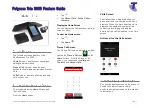
To turn off the microphone when you are using the speaker, press
!
. This will
mute your voice so the other party cannot hear you.
Use the Hands-Free Answer on Intercom (HFAI) feature to answer
voice-signaled calls without lifting the handset (see below).
Hands-Free Answer on Intercom (HFAI)
When you receive a
voice-signaled intercom call, your phone beeps once to
indicate that your speaker has been turned on automatically, and you hear the
caller’s voice over your phone’s speaker. If you leave your microphone on all the
time, you can start talking when you hear the caller, without lifting the handset.
This feature is called
Hands-Free Answer on Intercom.
Any user in the system can make a voice-signaled call to an idle system phone
by pressing
i
*
then dialing an extension number or pressing an Auto
Dial button programmed for voice signaling. (You can make a voice-signaled
call
from either a system phone or a standard phone. However, if you try to
make a voice-signaled call
to a standard phone or an MLC-6 or TransTalk
9000-series phone, it will ring.)
NOTES:
1.
The HFAI feature can be turned on or off only when your phone is idle. Muting
your voice while you are on a call only turns off the microphone for the duration
of the call.
2.
If HFAI is on and you are already on a call, you will not receive any voice-
signaled calls to your extension—they will ring instead.
3.
If you make a voice-signaled intercom call to a
busy extension, it may result
in a voice interrupt on busy call to that extension. See “Voice Interrupt On
Busy Calls” on the next page for more information.
Voice Interrupt on Busy Calls
A voice interrupt on busy call is a special intercom call that lets you interrupt and
speak to another user who is busy on a call and who has the
Voice Interrupt On
Busy
(#312)
feature activated. When you use Voice Interrupt on Busy, the
interrupted user hears two beeps before hearing your voice. Be aware that the
third party to whom the interrupted user is speaking will probably hear the two
beeps and the faint sound of your voice. Therefore, the message you deliver
with the interruption should be brief and discreet. If the interrupted user wants to
answer you, he or she can press a programmed Talk-Back button—the
interrupted user’s response cannot be heard by the third party in this case.
3-6
Learning About Telephones
Содержание PARTNER Advanced Communications System Release 1.0
Страница 6: ...iv...
















































